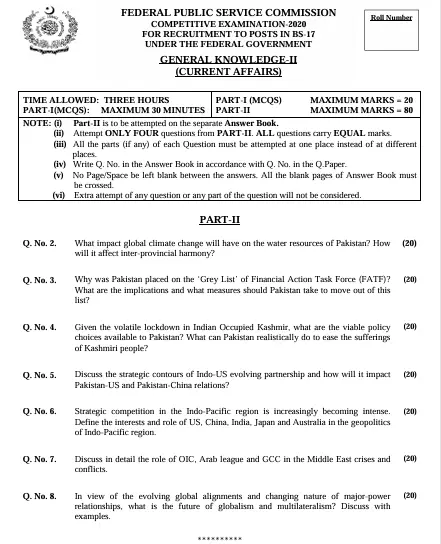Table of Contents
ToggleCSS Current Affairs Paper 2020
PART-II
Q. No. 2. What impact global climate change will have on the water resources of Pakistan? How will it affect inter-provincial harmony? (20)
Q. No. 3. Why was Pakistan placed on the ‘Grey List’ of the Financial Action Task Force (FATF)? What are the implications, and what measures should Pakistan take to move out of this list? (20)
Q. No. 4. Given the volatile lockdown in Indian-Occupied Kashmir, what are the viable policy choices available to Pakistan? What can Pakistan realistically do to ease the suffering of the Kashmiri people? (20)
Q. No. 5. Discuss the strategic contours of the Indo-US evolving partnership and how will it impact Pakistan-US and Pakistan-China relations. (20)
Q. No. 6. Strategic competition in the Indo-Pacific region is increasingly becoming intense. Define the interests and role of the US, China, India, Japan,, and Australia in the geopolitics of the Indo-Pacific region. (20)
Q. No. 7. Discuss in detail the role of the OIC, Arab League, and GCC in the Middle East crises and conflicts. (20)
Q. No. 8. In view of the evolving global alignments and changing nature of major-power relationships, what is the future of globalism and multilateralism? Discuss with examples.(20)
Summary:
Q. No. 2: What impact global climate change will have on the water resources of Pakistan? How will it affect inter-provincial harmony? (20)
Impact on Water Resources:
- Glacial Melting: Accelerated melting of glaciers in the Himalayas disrupts river flows.
- Erratic Rainfall: Unpredictable monsoons increase droughts and floods.
- Depletion of Aquifers: Over-extraction due to reduced surface water exacerbates scarcity.
Impact on Inter-Provincial Harmony:
- Water Disputes: Provinces may compete over dwindling supplies (e.g., Sindh-Punjab disagreements over Indus water).
- Agricultural Losses: Intensifies grievances in provinces dependent on irrigation.
- Political Polarization: Weakens national unity over equitable distribution.
Recommendations:
- Implement water conservation technologies.
- Strengthen inter-provincial agreements under the 1991 Water Accord.
- Adopt climate-resilient policies and invest in sustainable infrastructure.
Q. No. 3: Why was Pakistan placed on the ‘Grey List’ of the Financial Action Task Force (FATF)? What are the implications, and what measures should Pakistan take to move out of this list? (20)
Reasons for Grey-Listing:
- Terror Financing: Alleged inability to curb funding of banned organizations.
- Money Laundering: Inadequate controls on financial transactions.
- Weak Legal Frameworks: Deficiencies in prosecuting financial crimes.
Implications:
- Economic Losses: Decline in foreign investment and international credit ratings.
- Reputational Damage: Negative global perception of Pakistan’s financial system.
- Geopolitical Pressure: Increased scrutiny from global powers.
Measures to Exit:
- Strengthen anti-money laundering and counter-terror financing laws.
- Enhance transparency in banking and financial transactions.
- Implement FATF’s action plans and engage in proactive diplomacy.
Q. No. 4: Given the volatile lockdown in Indian-Occupied Kashmir, what are the viable policy choices available to Pakistan? What can Pakistan realistically do to ease the suffering of the Kashmiri people? (20)
Viable Policy Choices:
- Diplomatic Engagement: Highlight the issue at international forums (UN, OIC, etc.).
- Human Rights Advocacy: Collaborate with NGOs to expose abuses.
- Economic Sanctions Advocacy: Push for targeted sanctions on India over human rights violations.
Realistic Actions:
- Provide moral and financial support to Kashmiri activists.
- Facilitate humanitarian aid through international channels.
- Strengthen media campaigns to counter Indian narratives globally.
Limitations: Escalation risks and limited leverage over India.
Q. No. 5: Discuss the strategic contours of the Indo-US evolving partnership and how will it impact Pakistan-US and Pakistan-China relations. (20)
Strategic Contours:
- Defense Collaboration: India’s designation as a “Major Defense Partner” and defense technology transfers.
- Economic Ties: Boosting trade and investments under initiatives like IPEF.
- China Containment: Indo-US alignment to counter China in the Indo-Pacific.
Impacts:
- Pakistan-US Relations: Shift in US focus toward India marginalizes Pakistan.
- Pakistan-China Relations: Strengthens Pakistan’s reliance on China for strategic and economic support.
- Regional Polarization: Escalates security concerns for Pakistan in South Asia.
Q. No. 6: Strategic competition in the Indo-Pacific region is increasingly becoming intense. Define the interests and role of the US, China, India, Japan, and Australia in the geopolitics of the Indo-Pacific region. (20)
US Interests: Maintaining dominance through alliances like QUAD and securing sea lanes.
China’s Role: Expanding influence via the Belt and Road Initiative and military assertiveness in the South China Sea.
India’s Position: Balancing China’s rise through Indo-Pacific partnerships.
Japan’s Role: Economic Partnerships and security alliances with QUAD countries.
Australia’s Role: Contributing to regional stability as part of AUKUS and QUAD.
Geopolitical Dynamics:
- US-China Rivalry: Dominates the region’s strategic landscape.
- Alliances: Increasingly shape economic and military engagements.
Q. No. 7: Discuss in detail the role of the OIC, Arab League, and GCC in the Middle East crises and conflicts. (20)
OIC: Primarily symbolic, often criticized for inefficacy in resolving crises like Palestine and Syria.
Arab League: Limited success due to internal divisions, but instrumental in mediating some disputes.
GCC: Economic cooperation overshadowed by internal rifts (e.g., Qatar crisis).
Challenges:
- Sectarian rivalries.
- External interference (US, Russia, etc.).
- Weak institutional frameworks.
Recommendations: Reforms to strengthen collective decision-making and neutrality.
Q. No. 8: In view of the evolving global alignments and changing nature of major-power relationships, what is the future of globalism and multilateralism? Discuss with examples. (20)
Future of Globalism:
- Resurgence of Nationalism: Challenges to multilateral frameworks (e.g., Brexit, US-China trade war).
- Regionalism: Greater focus on regional organizations like ASEAN and SCO.
- Emerging Economies: Countries like China and India driving multipolarity.
Examples:
- Climate Agreements: Mixed success with Paris Agreement and COP initiatives.
- Pandemic Response: Fragmented global cooperation during COVID-19.
Conclusion: While multilateralism faces challenges, collaborative efforts in trade, climate, and health remain crucial for global stability.
